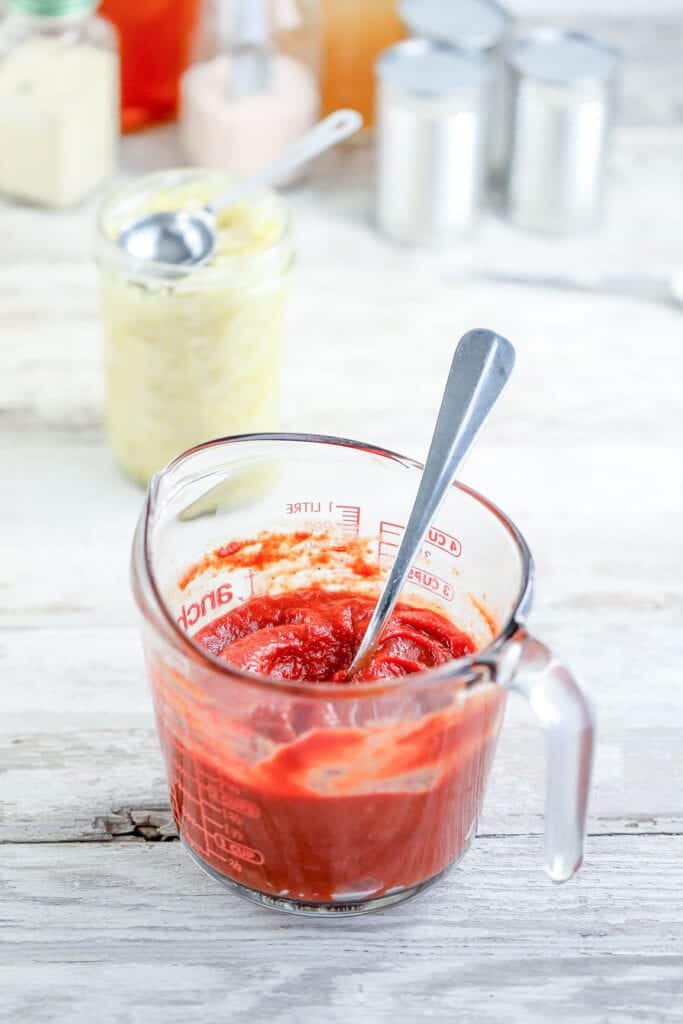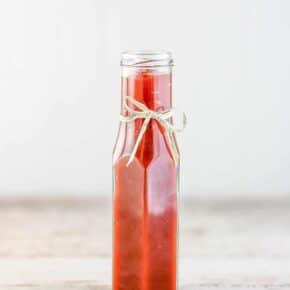How to Make Fermented Ketchup
Transforming a favorite condiment like Ketchup, into a fermented tomato ketchup is one of the easiest way to fit fermented foods into mealtimes. Even the pickiest of eaters will love this Fermented Ketchup other French fries!

I’m pretty obsessed with fermented foods to boost their healthy benefits, like with my Fermented Mango Habenero Hot Sauce, Kefir and Kombucha. I’ve even written the popular cookbook Fermented Foods at Every Meal cookbook to help guide you through getting your family on the probiotic train too, with other fermented recipes.
The History of Ketchup
With the global ketchup sales will reaching whopping $3.3 billion in 2015, according to a Global Industry Analysts Inc. report. Ketchup is a favorite condiment. But there’s more to this sauce than hamburgers and hot dogs. In fact, ketchup has a storied past that dates back to imperial China.

Believe it or not, the ancestor of modern ketchup was completely tomato-free.
Instead, the precursor to our ketchup of today was a fermented fish sauce from south- ern China. As far back as 300 BCE, texts began documenting the use of fermented pastes made from fish entrails, meat by-products, and soybeans. The fish sauce, called ge-thcup or koe-cheup by speakers of the Southern Min dialect, was easy to store on long ocean voyages. It spread along trade routes to Indonesia and the Philippines, where British traders developed a taste for the salty condiment by the early 1700s.
They took samples home and promptly adapted the original recipe.
The nineteenth century was a golden age for ketchup. Cookbooks featured recipes for ketchups made of oysters, mussels, mushrooms, walnuts, lemons, celery, and even fruits such as plums and peaches.
Finally, in 1812, the first recipe for tomato ketchup made its debut. James Mease, a Philadelphia scientist, wrote that the choicest ketchup came from “love apples,” as tomatoes were then called.

If you are worried that your family won’t like Homemade Ketchup, No Worries!! I’ve got you covered. Did you know that you can ferment store bought condiments, including your favorite brand of ketchup??
How to make Lacto Fermented Ketchup
My Fermented Ketchup Recipe is so easy! All you need it your favorite ketchup and some whey. I do suggest using a ketchup free of high fructose corn syrup, because it’s simply unhealhty on it’s own. Choose an organic ketchup, if possible.
Or you can always make homemade tomato ketchup from scratch using regular grocery store ingredients.
This Lacto Fermented Ketchup Recipe uses Whey. Whey is created during the fermentation process of other things like yogurt. Since whey is made with dairy, to make this Homemade Fermented Ketchup without whey (dairy), use THIS vegetable ferment starter culture or the liquid from another vegetable ferment.
To make Fermented Ketchup you’ll need these things:
- Ketchup
- Whey or vegetable ferment starter culture.
- Mason Jar
By adding whey to your favorite ketchup, the good batceria in the whey will allow natural fermentation to take place. Magically transforming the sugars into probiotics.

Fermented ketchup will keep in the store for well over a month in the fridge. The good bacteria prevent spoiling.
How to Ferment Store Bought Condiments
Fermenting store-bought condiments is a quick and easy way to sneak fermented foods into every meal. It’s especially useful if there’s a particular brand you prefer.

All that is needed is 1 tablespoon of whey or fermented vegetable brine for each 1 cup of ketchup, mustard, or other condiment. For example, you would add 3 tablespoons of whey to a 24-ounce bottle of ketchup. Then follow the instructions for fermentation.
Horseradish, ketchup, mustard, and salsa can be left to ferment at room temperature for 2 to 3 days. Mayonnaise should be left for only 8 hours before moving it to the refrigerator.
Yours in Health,


How to Make Fermented Ketchup
Ingredients
- 2 cups tomato paste
- 1/4 cup sugar
- 1/3 cup Whey
- 2 tablespoons Apple Cider Vinegar
- 1 teaspoon sea salt
- 1 teaspoon ground allspice
- ½ teaspoon ground cloves
Instructions
- Mix the tomato paste and honey in a bowl. Whisk in roughly ¼ cup of the Whey with vinegar, salt, allspice, and cloves. Continue blending until all the ingredients are evenly dispersed and the mixture is smooth.

- Spoon the homemade ketchup into a glass jar, top with the remaining Whey, and cover with cheesecloth secured with a rubber band or string. Let sit undisturbed at room temperature, out of direct sunlight, for 3 days.

- After 3 days, uncover the ketchup and stir it thoroughly. Cover with an airtight lid and transfer to the refrigerator for storage. You can use it immediately, or store it in the refrigerator for several months.










